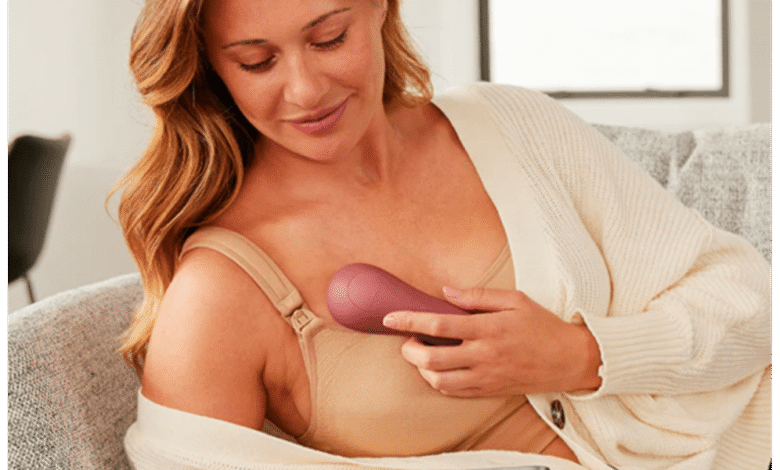Everything You Need to Know About Lactation Massagers

Introduction
If you’re breastfeeding or pumping, chances are you’ve dealt with that uncomfortable heaviness or the telltale ache of a clogged duct. I remember those early weeks vividly — juggling feedings, pumping, and trying to find relief from the constant pressure. That’s when I discovered how much difference a good lactation massager can make.
A lactation massager is a small handheld or wearable device that uses vibration, warmth, or gentle kneading to support milk flow, ease engorgement, and relieve tenderness. It’s not a substitute for nursing or proper latch, but it can make the whole process smoother and far more comfortable.
In this guide, I’ll walk you through how lactation massagers work, their benefits, and the best ways to use them safely. I’ll also share a few lessons learned from personal experience and other moms who’ve used these devices to make breastfeeding a little easier — and a lot less painful.
Benefits of Using a Lactation Massager
Stimulating Let-Down & Milk Flow
A lactation massager can do wonders for encouraging let-down. The gentle vibration stimulates oxytocin, the hormone responsible for milk release, helping milk move through the ducts more easily. Many moms notice they pump or express milk more efficiently when they use a massager before or during sessions.
Relieving Engorgement & Clogged Ducts
When your breasts feel hard, swollen, or lumpy, using a massager can help loosen blockages and soften the tissue. The rhythmic vibrations help break up clogs so milk can flow freely again. Regular use can also reduce the chances of those painful clogs turning into mastitis — something every nursing mom wants to avoid.
Comfort & Pain Relief
The warmth and movement from a lactation massager help boost circulation, easing soreness and tension in sensitive areas. During the early postpartum days, when everything feels tender, this extra bit of comfort can make feeding or pumping far more manageable.
Supporting Milk Supply
Efficient drainage signals your body to produce more milk. Using a lactation massager helps ensure your breasts empty more completely, which can support and even improve supply over time. It’s one of those small habits that can make a big difference in the long run.
Preventing Future Issues
Even if you’re not dealing with pain, gentle massage helps keep your milk ducts clear and healthy. Making it part of your daily routine can prevent build-up and reduce future discomfort.
Use With Care
As helpful as they are, lactation massagers should always be used gently. Too much pressure or intensity can irritate the skin or breast tissue. Start with low settings, move slowly, and listen to your body. And if you’re unsure, a quick check-in with a lactation consultant can help.
Types of Lactation Massagers
Not every massager works the same way — some are simple, others come loaded with features. Here’s a quick rundown of what’s out there:
Basic Manual or Vibrating Models
These are small, handheld devices powered by batteries or USB. They provide steady vibration to help with let-down and blockages but don’t usually include heating.
Warming + Vibration Designs
These combine mild heat with vibration for added comfort and better milk flow. The warmth helps soften tissue, which is great before or during a pumping session.
Wearable or In-Bra Massagers
For multitasking moms, these are a lifesaver. They fit inside your bra and can be used hands-free — discreet enough for use while working, pumping, or just relaxing.
Adjustable Intensity & Modes
Some massagers offer multiple speed or kneading modes, so you can tailor the experience to what feels right for you. This flexibility is especially helpful if you have sensitive areas or recurring clogs.
Waterproof & Easy-to-Clean Options
Waterproof models made from soft silicone are ideal since they’re easier to rinse, sanitize, and keep hygienic — something that matters when you’re using them daily.
How to Use a Lactation Massager Safely
Knowing how to use your lactation massager correctly helps you get results while avoiding irritation.
Preparation
- Wash your hands and clean the device before every use.
- Applying a warm compress for a minute or two beforehand helps relax the tissue.
Timing
The best times to use a lactation massager are:
- Before feeding or pumping: to encourage milk flow.
- During pumping: to help with let-down and improve drainage.
- After feeding: to relieve fullness or lingering tension.
A few minutes per side is usually plenty — you don’t need to overdo it.
Technique
- Move the device in gentle circular motions from the outer breast toward the nipple.
- Apply light, steady pressure — firm enough to feel movement but never uncomfortable.
- Focus on any firm or tender spots but start on a low setting.
Safety Tips
- Avoid using it on broken skin or areas of infection.
- Stop immediately if you feel sharp pain or swelling.
- Always follow the cleaning and care instructions specific to your device.
Hygiene & Maintenance
After every use, wash the massager with mild soap and warm water. If it’s waterproof, you can rinse it thoroughly and air dry it. Avoid harsh cleaners that can damage silicone or other soft materials.
Choosing the Right Lactation Massager
When it comes to choosing the best lactation massager, comfort and practicality should come first.
Comfort & Shape
Look for a design that fits naturally against your body. Ergonomic, curved shapes make it easier to reach all areas without strain.
Vibration & Heat Settings
Multiple intensity options let you adjust based on your comfort level. Heat can make a big difference when your breasts feel engorged or when you’re trying to clear a stubborn clog.
Battery & Power
Rechargeable models are more convenient — especially those with USB-C charging that can plug into your laptop or power bank.
Material & Safety
Always go for BPA-free, food-grade silicone that’s gentle on skin and easy to sanitize.
Ease of Cleaning
Simpler designs with fewer crevices are best — the less time spent cleaning, the better.
A Reliable Option Worth Considering
One standout option is the Momcozy 3 Mode Adjustable Kneading Lactation Massager. It’s designed with three customizable modes, combining gentle heat and kneading motion to ease engorgement and improve milk flow. The curved, soft-touch design makes it comfortable to use directly against the breast, and the compact size means it fits easily inside your bra for hands-free relief. For busy moms, it’s a thoughtful tool that helps make each pumping or nursing session more productive and comfortable.
Common Questions & Troubleshooting
Q: Is a lactation massager necessary?
Not always — but it can be a real game-changer if you’re struggling with clogged ducts, soreness, or slow flow. Think of it as a support tool that makes breastfeeding more manageable.
Q: Can I use it while pumping?
Yes! In fact, using it during pumping often improves output. Some moms even tuck wearable versions into their bras while using a pump for extra stimulation and faster drainage.
Q: What if I feel pain after using it?
Stop right away and reach out to a lactation consultant or healthcare provider. Pain might mean too much pressure or an underlying issue that needs attention.
Q: How often should I use it?
Once or twice a day is usually enough. You can use it more often during periods of engorgement — just keep it gentle and short.
Conclusion
A lactation massager isn’t an absolute must, but for many moms, it’s one of those small comforts that make a huge difference. Whether you’re dealing with engorgement, clogs, or just want to make pumping more efficient, it can help you feel better and keep your milk flowing smoothly.
The key is using it gently and consistently — and always in tune with your body’s signals. With the right balance of warmth, movement, and care, a lactation massager can turn uncomfortable feeding sessions into moments of relief and reassurance.
Personally, tools like the Momcozy 3 Mode Adjustable Kneading Lactation Massager have helped me feel more in control of my breastfeeding journey. It’s one of those quiet little helpers that brings comfort, confidence, and calm back into the mix — and that’s something every mom deserves.




